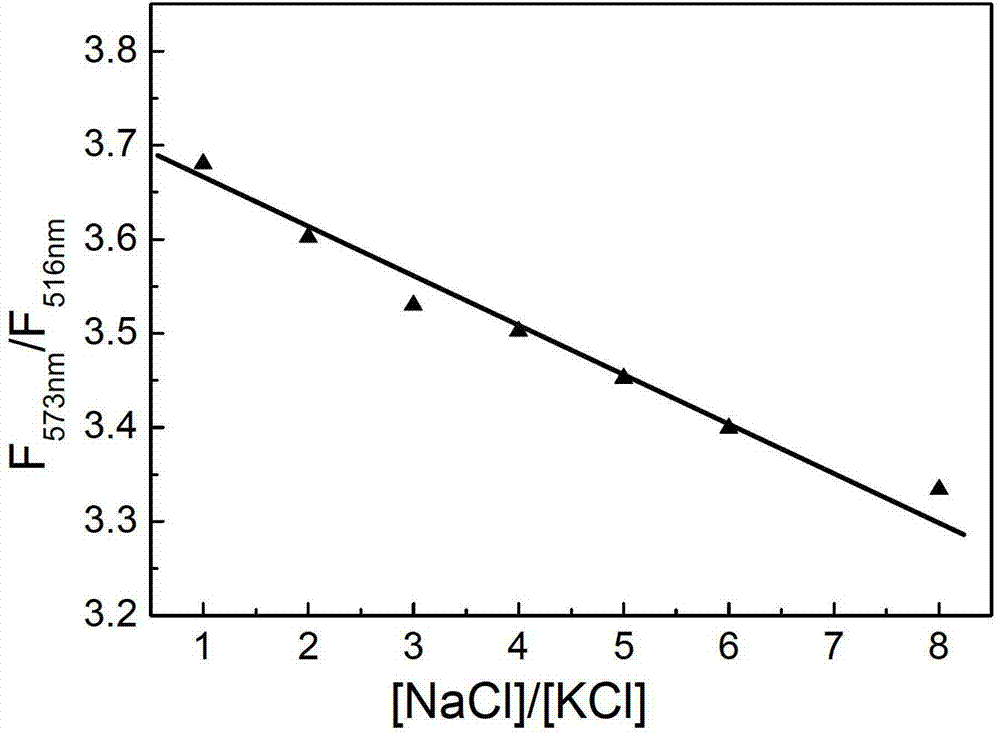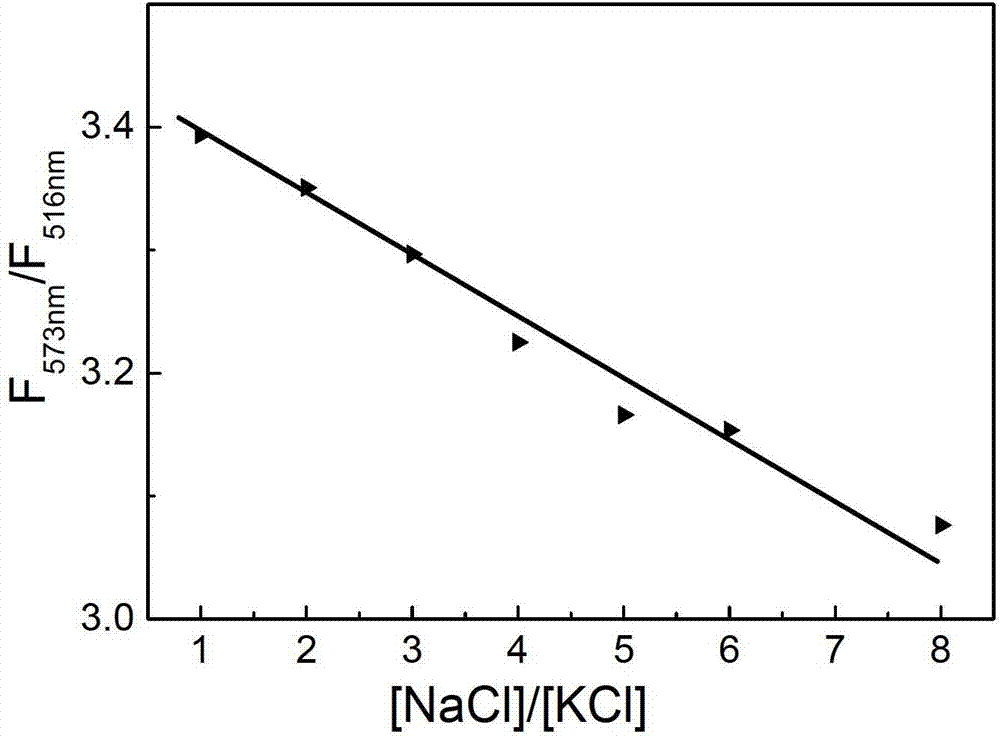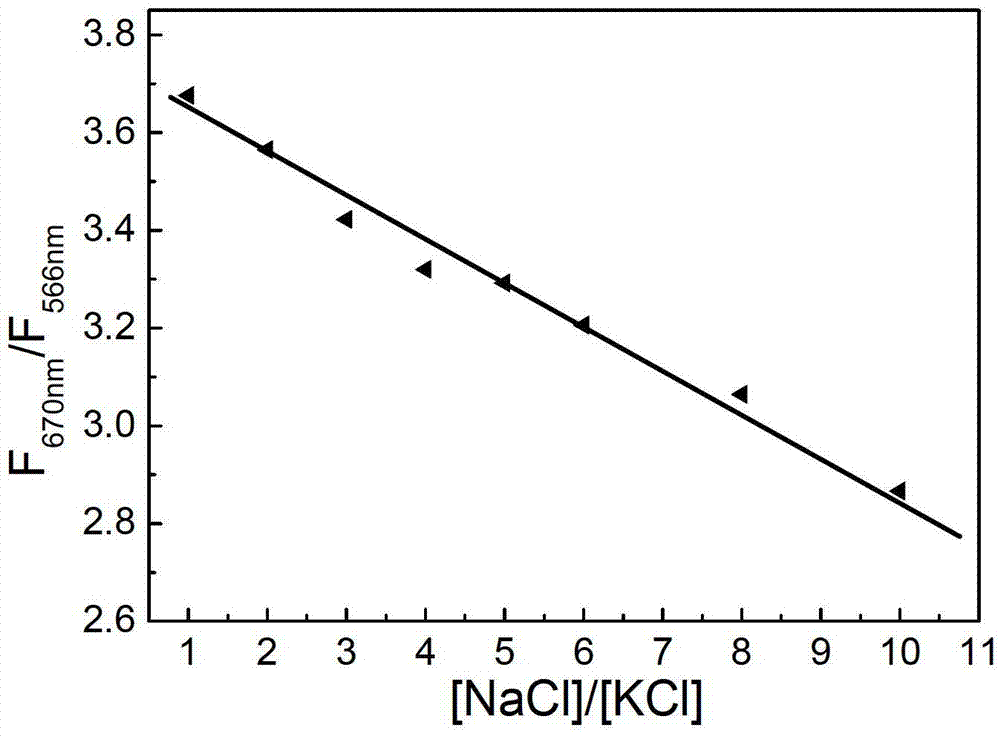Sodium/ potassium ion ratio detecting method, system and kit
A technology of potassium ions and kits, applied in the field of biomedicine, can solve the problems of direct measurement of sodium/potassium ratio, complicated operation, large error, etc., and achieve the effect of low test cost, simple operation and high specificity
- Summary
- Abstract
- Description
- Claims
- Application Information
AI Technical Summary
Problems solved by technology
Method used
Image
Examples
Embodiment 1
[0057] The base sequence in the DNA molecules with fluorescent labeling groups that can form different G-quadruplex structures in the presence of sodium and potassium ions used in this example is AGGGTTAGGGTTAGGGTTAGGG, and the fluorescent labeling group is 6-carboxyl Fluorescein (FAM) and 6-carboxytetramethylrhodamine (TAMRA).
[0058] 1) Prepare standard solution samples and test solutions
[0059] A certain amount of DNA was dissolved in Tris-HCl buffer solution with a pH value of 7.2 to prepare a DNA stock solution with a concentration of 0.7 μmol / L for later use.
[0060] Take 150 μL each of the 11 parts of the above-mentioned DNA mother solution, and add 350 μL of sodium / potassium ion ratios to 8 parts of the DNA solution, respectively 1 (100 mmol / 100 mmol), 2 (50 mmol / 25 mmol), 3 (75 mmol / 25 mmol), 4 (80mmol / 20mmol), 5 (100mmol / 20mmol), 6 (300mmol / 50mmol), 7 (70mmol / 10mmol), 8 (800mmol / 100mmol) solutions, get 8 standard solution samples;
[0061] Add 350 μL of urine s...
Embodiment 2
[0070] The base sequence in the DNA molecules that can form different G-quadruplex structures in the presence of sodium and potassium ions with fluorescent labeling groups used in this example is TTAGGGTTAGGGTTAGGGTTAGGG, and the fluorescent labeling groups used are 6-carboxyfluorescein (FAM) and 6-carboxytetramethylrhodamine (TAMRA)
[0071] 1) Prepare standard solution samples and test solutions
[0072] A certain amount of DNA was dissolved in a boric acid-borax buffer solution with a pH value of 8.2 to prepare a DNA mother solution with a concentration of 1.5 μmol / L for later use.
[0073] Take 75 μL of each of the 11 parts of the above DNA mother solution, and add 425 μL of sodium / potassium ion ratios to 8 parts of the DNA solution. (40mmol / 10mmol), 5 (100mmol / 20mmol), 6 (120mmol / 20mmol), 7 (35mmol / 5mmol), 8 (80mmol / 10mmol) solutions to obtain 8 standard solution samples.
[0074]Add 425 μL of saliva sample to the other 3 DNA solutions to obtain 3 test solutions.
[00...
Embodiment 3
[0082] The base sequence in the DNA molecule capable of forming a G quadruplex with a fluorescent labeling group used in this example is GGGCCAGGGAGCGGGGCGGAGGGGG, and the fluorescent labeling molecules used are 3H-indocyanine dye (Cy3) and 3H- Indocyanine dye (Cy5).
[0083] 1) Prepare standard solution samples and test solutions
[0084] A certain amount of DNA was dissolved in a boric acid-borax buffer solution with a pH value of 7.4 to prepare a DNA mother solution with a concentration of 2 μmol / L for later use.
[0085] Take 300 μL each of 11 parts of the above-mentioned DNA mother solution, and add 200 μL of solutions with sodium / potassium ion ratios of 1, 2, 3, 4, 5, 6, 8, and 10 to 8 of the DNA solutions to obtain 8 standards Solution sample.
[0086] Add 200 μL of serum samples to the other 3 DNA solutions to obtain 3 test solutions.
[0087] 2) Detection analysis
[0088] The above samples were analyzed by fluorescence spectrometer respectively. All operations w...
PUM
 Login to View More
Login to View More Abstract
Description
Claims
Application Information
 Login to View More
Login to View More - R&D
- Intellectual Property
- Life Sciences
- Materials
- Tech Scout
- Unparalleled Data Quality
- Higher Quality Content
- 60% Fewer Hallucinations
Browse by: Latest US Patents, China's latest patents, Technical Efficacy Thesaurus, Application Domain, Technology Topic, Popular Technical Reports.
© 2025 PatSnap. All rights reserved.Legal|Privacy policy|Modern Slavery Act Transparency Statement|Sitemap|About US| Contact US: help@patsnap.com



